Multiclass classification problems are those where a label must be predicted, but there are more than two labels that may be predicted.
These are challenging predictive modeling problems because a sufficiently representative number of examples of each class is required for a model to learn the problem. It is made challenging when the number of examples in each class is imbalanced, or skewed toward one or a few of the classes with very few examples of other classes.
Problems of this type are referred to as imbalanced multiclass classification problems and they require both the careful design of an evaluation metric and test harness and choice of machine learning models. The E.coli protein localization sites dataset is a standard dataset for exploring the challenge of imbalanced multiclass classification.
In this tutorial, you will discover how to develop and evaluate a model for the imbalanced multiclass E.coli dataset.
After completing this tutorial, you will know:
- How to load and explore the dataset and generate ideas for data preparation and model selection.
- How to systematically evaluate a suite of machine learning models with a robust test harness.
- How to fit a final model and use it to predict the class labels for specific examples.
Kick-start your project with my new book Imbalanced Classification with Python, including step-by-step tutorials and the Python source code files for all examples.
Let’s get started.
- Updated Jan/2021: Updated links for API documentation.

Imbalanced Multiclass Classification with the E.coli Dataset
Photo by Marcus, some rights reserved.
Tutorial Overview
This tutorial is divided into five parts; they are:
- E.coli Dataset
- Explore the Dataset
- Model Test and Baseline Result
- Evaluate Models
- Evaluate Machine Learning Algorithms
- Evaluate Data Oversampling
- Make Predictions on New Data
E.coli Dataset
In this project, we will use a standard imbalanced machine learning dataset referred to as the “E.coli” dataset, also referred to as the “protein localization sites” dataset.
The dataset describes the problem of classifying E.coli proteins using their amino acid sequences in their cell localization sites. That is, predicting how a protein will bind to a cell based on the chemical composition of the protein before it is folded.
The dataset is credited to Kenta Nakai and was developed into its current form by Paul Horton and Kenta Nakai in their 1996 paper titled “A Probabilistic Classification System For Predicting The Cellular Localization Sites Of Proteins.” In it, they achieved a classification accuracy of 81 percent.
336 E.coli proteins were classified into 8 classes with an accuracy of 81% …
— A Probabilistic Classification System For Predicting The Cellular Localization Sites Of Proteins, 1996.
The dataset is comprised of 336 examples of E.coli proteins and each example is described using seven input variables calculated from the proteins amino acid sequence.
Ignoring the sequence name, the input features are described as follows:
- mcg: McGeoch’s method for signal sequence recognition.
- gvh: von Heijne’s method for signal sequence recognition.
- lip: von Heijne’s Signal Peptidase II consensus sequence score.
- chg: Presence of charge on N-terminus of predicted lipoproteins.
- aac: score of discriminant analysis of the amino acid content of outer membrane and periplasmic proteins.
- alm1: score of the ALOM membrane-spanning region prediction program.
- alm2: score of ALOM program after excluding putative cleavable signal regions from the sequence.
There are eight classes described as follows:
- cp: cytoplasm
- im: inner membrane without signal sequence
- pp: periplasm
- imU: inner membrane, non cleavable signal sequence
- om: outer membrane
- omL: outer membrane lipoprotein
- imL: inner membrane lipoprotein
- imS: inner membrane, cleavable signal sequence
The distribution of examples across the classes is not equal and in some cases severely imbalanced.
For example, the “cp” class has 143 examples, whereas the “imL” and “imS” classes have just two examples each.
Next, let’s take a closer look at the data.
Want to Get Started With Imbalance Classification?
Take my free 7-day email crash course now (with sample code).
Click to sign-up and also get a free PDF Ebook version of the course.
Explore the Dataset
First, download and unzip the dataset and save it in your current working directory with the name “ecoli.csv“.
Note that this version of the dataset has the first column (sequence name) removed as it does not contain generalizable information for modeling.
Review the contents of the file.
The first few lines of the file should look as follows:
|
1 2 3 4 5 6 |
0.49,0.29,0.48,0.50,0.56,0.24,0.35,cp 0.07,0.40,0.48,0.50,0.54,0.35,0.44,cp 0.56,0.40,0.48,0.50,0.49,0.37,0.46,cp 0.59,0.49,0.48,0.50,0.52,0.45,0.36,cp 0.23,0.32,0.48,0.50,0.55,0.25,0.35,cp ... |
We can see that the input variables all appear numeric, and the class labels are string values that will need to be label encoded prior to modeling.
The dataset can be loaded as a DataFrame using the read_csv() Pandas function, specifying the location of the file and the fact that there is no header line.
|
1 2 3 4 5 |
... # define the dataset location filename = 'ecoli.csv' # load the csv file as a data frame dataframe = read_csv(filename, header=None) |
Once loaded, we can summarize the number of rows and columns by printing the shape of the DataFrame.
|
1 2 3 |
... # summarize the shape of the dataset print(dataframe.shape) |
Next, we can calculate a five-number summary for each input variable.
|
1 2 3 4 |
... # describe the dataset set_option('precision', 3) print(dataframe.describe()) |
Finally, we can also summarize the number of examples in each class using the Counter object.
|
1 2 3 4 5 6 7 |
... # summarize the class distribution target = dataframe.values[:,-1] counter = Counter(target) for k,v in counter.items(): per = v / len(target) * 100 print('Class=%s, Count=%d, Percentage=%.3f%%' % (k, v, per)) |
Tying this together, the complete example of loading and summarizing the dataset is listed below.
|
1 2 3 4 5 6 7 8 9 10 11 12 13 14 15 16 17 18 19 |
# load and summarize the dataset from pandas import read_csv from pandas import set_option from collections import Counter # define the dataset location filename = 'ecoli.csv' # load the csv file as a data frame dataframe = read_csv(filename, header=None) # summarize the shape of the dataset print(dataframe.shape) # describe the dataset set_option('precision', 3) print(dataframe.describe()) # summarize the class distribution target = dataframe.values[:,-1] counter = Counter(target) for k,v in counter.items(): per = v / len(target) * 100 print('Class=%s, Count=%d, Percentage=%.3f%%' % (k, v, per)) |
Running the example first loads the dataset and confirms the number of rows and columns, which are 336 rows and 7 input variables and 1 target variable.
Reviewing the summary of each variable, it appears that the variables have been centered, that is, shifted to have a mean of 0.5. It also appears that the variables have been normalized, meaning all values are in the range between about 0 and 1; at least no variables have values outside this range.
The class distribution is then summarized, confirming the severe skew in the observations for each class. We can see that the “cp” class is dominant with about 42 percent of the examples and minority classes such as “imS“, “imL“, and “omL” have about 1 percent or less of the dataset.
There may not be sufficient data to generalize from these minority classes. One approach might be to simply remove the examples with these classes.
|
1 2 3 4 5 6 7 8 9 10 11 12 13 14 15 16 17 18 19 |
(336, 8) 0 1 2 3 4 5 6 count 336.000 336.000 336.000 336.000 336.000 336.000 336.000 mean 0.500 0.500 0.495 0.501 0.500 0.500 0.500 std 0.195 0.148 0.088 0.027 0.122 0.216 0.209 min 0.000 0.160 0.480 0.500 0.000 0.030 0.000 25% 0.340 0.400 0.480 0.500 0.420 0.330 0.350 50% 0.500 0.470 0.480 0.500 0.495 0.455 0.430 75% 0.662 0.570 0.480 0.500 0.570 0.710 0.710 max 0.890 1.000 1.000 1.000 0.880 1.000 0.990 Class=cp, Count=143, Percentage=42.560% Class=im, Count=77, Percentage=22.917% Class=imS, Count=2, Percentage=0.595% Class=imL, Count=2, Percentage=0.595% Class=imU, Count=35, Percentage=10.417% Class=om, Count=20, Percentage=5.952% Class=omL, Count=5, Percentage=1.488% Class=pp, Count=52, Percentage=15.476% |
We can also take a look at the distribution of the input variables by creating a histogram for each.
The complete example of creating histograms of all input variables is listed below.
|
1 2 3 4 5 6 7 8 9 10 11 |
# create histograms of all variables from pandas import read_csv from matplotlib import pyplot # define the dataset location filename = 'ecoli.csv' # load the csv file as a data frame df = read_csv(filename, header=None) # create a histogram plot of each variable df.hist(bins=25) # show the plot pyplot.show() |
We can see that variables such as 0, 5, and 6 may have a multi-modal distribution. The variables 2 and 3 may have a binary distribution and variables 1 and 4 may have a Gaussian-like distribution.
Depending on the choice of model, the dataset may benefit from standardization, normalization, and perhaps a power transform.
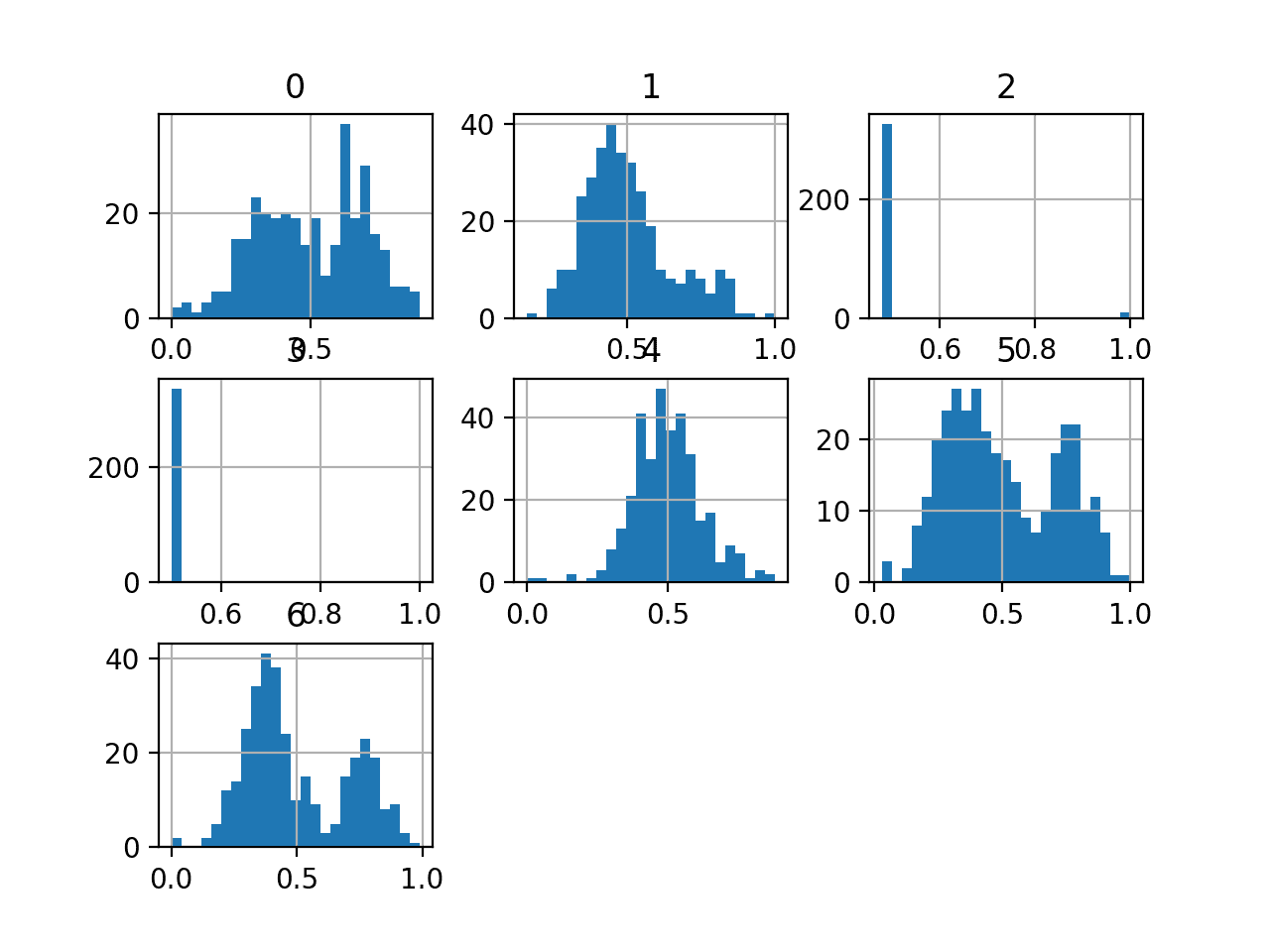
Histogram of Variables in the E.coli Dataset
Now that we have reviewed the dataset, let’s look at developing a test harness for evaluating candidate models.
Model Test and Baseline Result
The k-fold cross-validation procedure provides a good general estimate of model performance that is not too optimistically biased, at least compared to a single train-test split. We will use k=5, meaning each fold will contain about 336/5 or about 67 examples.
Stratified means that each fold will aim to contain the same mixture of examples by class as the entire training dataset. Repeated means that the evaluation process will be performed multiple times to help avoid fluke results and better capture the variance of the chosen model. We will use three repeats.
This means a single model will be fit and evaluated 5 * 3, or 15, times and the mean and standard deviation of these runs will be reported.
This can be achieved using the RepeatedStratifiedKFold scikit-learn class.
All classes are equally important. As such, in this case, we will use classification accuracy to evaluate models.
First, we can define a function to load the dataset and split the input variables into inputs and output variables and use a label encoder to ensure class labels are numbered sequentially.
|
1 2 3 4 5 6 7 8 9 10 11 |
# load the dataset def load_dataset(full_path): # load the dataset as a numpy array data = read_csv(full_path, header=None) # retrieve numpy array data = data.values # split into input and output elements X, y = data[:, :-1], data[:, -1] # label encode the target variable to have the classes 0 and 1 y = LabelEncoder().fit_transform(y) return X, y |
We can define a function to evaluate a candidate model using stratified repeated 5-fold cross-validation, then return a list of scores calculated on the model for each fold and repeat.
The evaluate_model() function below implements this.
|
1 2 3 4 5 6 7 |
# evaluate a model def evaluate_model(X, y, model): # define evaluation procedure cv = RepeatedStratifiedKFold(n_splits=5, n_repeats=3, random_state=1) # evaluate model scores = cross_val_score(model, X, y, scoring='accuracy', cv=cv, n_jobs=-1) return scores |
We can then call the load_dataset() function to load and confirm the E.coli dataset.
|
1 2 3 4 5 6 7 |
... # define the location of the dataset full_path = 'ecoli.csv' # load the dataset X, y = load_dataset(full_path) # summarize the loaded dataset print(X.shape, y.shape, Counter(y)) |
In this case, we will evaluate the baseline strategy of predicting the majority class in all cases.
This can be implemented automatically using the DummyClassifier class and setting the “strategy” to “most_frequent” that will predict the most common class (e.g. class ‘cp‘) in the training dataset. As such, we would expect this model to achieve a classification accuracy of about 42 percent given this is the distribution of the most common class in the training dataset.
|
1 2 3 |
... # define the reference model model = DummyClassifier(strategy='most_frequent') |
We can then evaluate the model by calling our evaluate_model() function and report the mean and standard deviation of the results.
|
1 2 3 4 5 |
... # evaluate the model scores = evaluate_model(X, y, model) # summarize performance print('Mean Accuracy: %.3f (%.3f)' % (mean(scores), std(scores))) |
Tying this all together, the complete example of evaluating the baseline model on the E.coli dataset using classification accuracy is listed below.
|
1 2 3 4 5 6 7 8 9 10 11 12 13 14 15 16 17 18 19 20 21 22 23 24 25 26 27 28 29 30 31 32 33 34 35 36 37 38 39 40 41 42 |
# baseline model and test harness for the ecoli dataset from collections import Counter from numpy import mean from numpy import std from pandas import read_csv from sklearn.preprocessing import LabelEncoder from sklearn.model_selection import cross_val_score from sklearn.model_selection import RepeatedStratifiedKFold from sklearn.dummy import DummyClassifier # load the dataset def load_dataset(full_path): # load the dataset as a numpy array data = read_csv(full_path, header=None) # retrieve numpy array data = data.values # split into input and output elements X, y = data[:, :-1], data[:, -1] # label encode the target variable to have the classes 0 and 1 y = LabelEncoder().fit_transform(y) return X, y # evaluate a model def evaluate_model(X, y, model): # define evaluation procedure cv = RepeatedStratifiedKFold(n_splits=5, n_repeats=3, random_state=1) # evaluate model scores = cross_val_score(model, X, y, scoring='accuracy', cv=cv, n_jobs=-1) return scores # define the location of the dataset full_path = 'ecoli.csv' # load the dataset X, y = load_dataset(full_path) # summarize the loaded dataset print(X.shape, y.shape, Counter(y)) # define the reference model model = DummyClassifier(strategy='most_frequent') # evaluate the model scores = evaluate_model(X, y, model) # summarize performance print('Mean Accuracy: %.3f (%.3f)' % (mean(scores), std(scores))) |
Running the example first loads the dataset and reports the number of cases correctly as 336 and the distribution of class labels as we expect.
The DummyClassifier with our default strategy is then evaluated using repeated stratified k-fold cross-validation and the mean and standard deviation of the classification accuracy is reported as about 42.6 percent.
|
1 2 |
(336, 7) (336,) Counter({0: 143, 1: 77, 7: 52, 4: 35, 5: 20, 6: 5, 3: 2, 2: 2}) Mean Accuracy: 0.426 (0.006) |
Warnings are reported during the evaluation of the model; for example:
|
1 |
Warning: The least populated class in y has only 2 members, which is too few. The minimum number of members in any class cannot be less than n_splits=5. |
This is because some of the classes do not have a sufficient number of examples for the 5-fold cross-validation, e.g. classes “imS” and “imL“.
In this case, we will remove these examples from the dataset. This can be achieved by updating the load_dataset() to remove those rows with these classes, e.g. four rows.
|
1 2 3 4 5 6 7 8 9 10 11 12 13 14 |
# load the dataset def load_dataset(full_path): # load the dataset as a numpy array df = read_csv(full_path, header=None) # remove rows for the minority classes df = df[df[7] != 'imS'] df = df[df[7] != 'imL'] # retrieve numpy array data = df.values # split into input and output elements X, y = data[:, :-1], data[:, -1] # label encode the target variable to have the classes 0 and 1 y = LabelEncoder().fit_transform(y) return X, y |
We can then re-run the example to establish a baseline in classification accuracy.
The complete example is listed below.
|
1 2 3 4 5 6 7 8 9 10 11 12 13 14 15 16 17 18 19 20 21 22 23 24 25 26 27 28 29 30 31 32 33 34 35 36 37 38 39 40 41 42 43 44 45 |
# baseline model and test harness for the ecoli dataset from collections import Counter from numpy import mean from numpy import std from pandas import read_csv from sklearn.preprocessing import LabelEncoder from sklearn.model_selection import cross_val_score from sklearn.model_selection import RepeatedStratifiedKFold from sklearn.dummy import DummyClassifier # load the dataset def load_dataset(full_path): # load the dataset as a numpy array df = read_csv(full_path, header=None) # remove rows for the minority classes df = df[df[7] != 'imS'] df = df[df[7] != 'imL'] # retrieve numpy array data = df.values # split into input and output elements X, y = data[:, :-1], data[:, -1] # label encode the target variable to have the classes 0 and 1 y = LabelEncoder().fit_transform(y) return X, y # evaluate a model def evaluate_model(X, y, model): # define evaluation procedure cv = RepeatedStratifiedKFold(n_splits=5, n_repeats=3, random_state=1) # evaluate model scores = cross_val_score(model, X, y, scoring='accuracy', cv=cv, n_jobs=-1) return scores # define the location of the dataset full_path = 'ecoli.csv' # load the dataset X, y = load_dataset(full_path) # summarize the loaded dataset print(X.shape, y.shape, Counter(y)) # define the reference model model = DummyClassifier(strategy='most_frequent') # evaluate the model scores = evaluate_model(X, y, model) # summarize performance print('Mean Accuracy: %.3f (%.3f)' % (mean(scores), std(scores))) |
Running the example confirms that the number of examples was reduced by four, from 336 to 332.
We can also see that the number of classes was reduced from eight to six (class 0 through to class 5).
The baseline in performance was established at 43.1 percent. This score provides a baseline on this dataset by which all other classification algorithms can be compared. Achieving a score above about 43.1 percent indicates that a model has skill on this dataset, and a score at or below this value indicates that the model does not have skill on this dataset.
|
1 2 |
(332, 7) (332,) Counter({0: 143, 1: 77, 5: 52, 2: 35, 3: 20, 4: 5}) Mean Accuracy: 0.431 (0.005) |
Now that we have a test harness and a baseline in performance, we can begin to evaluate some models on this dataset.
Evaluate Models
In this section, we will evaluate a suite of different techniques on the dataset using the test harness developed in the previous section.
The reported performance is good, but not highly optimized (e.g. hyperparameters are not tuned).
Can you do better? If you can achieve better classification accuracy using the same test harness, I’d love to hear about it. Let me know in the comments below.
Evaluate Machine Learning Algorithms
Let’s start by evaluating a mixture of machine learning models on the dataset.
It can be a good idea to spot check a suite of different nonlinear algorithms on a dataset to quickly flush out what works well and deserves further attention, and what doesn’t.
We will evaluate the following machine learning models on the E.coli dataset:
- Linear Discriminant Analysis (LDA)
- Support Vector Machine (SVM)
- Bagged Decision Trees (BAG)
- Random Forest (RF)
- Extra Trees (ET)
We will use mostly default model hyperparameters, with the exception of the number of trees in the ensemble algorithms, which we will set to a reasonable default of 1,000.
We will define each model in turn and add them to a list so that we can evaluate them sequentially. The get_models() function below defines the list of models for evaluation, as well as a list of model short names for plotting the results later.
|
1 2 3 4 5 6 7 8 9 10 11 12 13 14 15 16 17 18 19 |
# define models to test def get_models(): models, names = list(), list() # LDA models.append(LinearDiscriminantAnalysis()) names.append('LDA') # SVM models.append(LinearSVC()) names.append('SVM') # Bagging models.append(BaggingClassifier(n_estimators=1000)) names.append('BAG') # RF models.append(RandomForestClassifier(n_estimators=1000)) names.append('RF') # ET models.append(ExtraTreesClassifier(n_estimators=1000)) names.append('ET') return models, names |
We can then enumerate the list of models in turn and evaluate each, storing the scores for later evaluation.
|
1 2 3 4 5 6 7 8 9 10 11 |
... # define models models, names = get_models() results = list() # evaluate each model for i in range(len(models)): # evaluate the model and store results scores = evaluate_model(X, y, models[i]) results.append(scores) # summarize performance print('>%s %.3f (%.3f)' % (names[i], mean(scores), std(scores))) |
At the end of the run, we can plot each sample of scores as a box and whisker plot with the same scale so that we can directly compare the distributions.
|
1 2 3 4 |
... # plot the results pyplot.boxplot(results, labels=names, showmeans=True) pyplot.show() |
Tying this all together, the complete example of evaluating a suite of machine learning algorithms on the E.coli dataset is listed below.
|
1 2 3 4 5 6 7 8 9 10 11 12 13 14 15 16 17 18 19 20 21 22 23 24 25 26 27 28 29 30 31 32 33 34 35 36 37 38 39 40 41 42 43 44 45 46 47 48 49 50 51 52 53 54 55 56 57 58 59 60 61 62 63 64 65 66 67 68 69 70 71 72 73 74 |
# spot check machine learning algorithms on the ecoli dataset from numpy import mean from numpy import std from pandas import read_csv from matplotlib import pyplot from sklearn.preprocessing import LabelEncoder from sklearn.model_selection import cross_val_score from sklearn.model_selection import RepeatedStratifiedKFold from sklearn.svm import LinearSVC from sklearn.discriminant_analysis import LinearDiscriminantAnalysis from sklearn.ensemble import RandomForestClassifier from sklearn.ensemble import ExtraTreesClassifier from sklearn.ensemble import BaggingClassifier # load the dataset def load_dataset(full_path): # load the dataset as a numpy array df = read_csv(full_path, header=None) # remove rows for the minority classes df = df[df[7] != 'imS'] df = df[df[7] != 'imL'] # retrieve numpy array data = df.values # split into input and output elements X, y = data[:, :-1], data[:, -1] # label encode the target variable y = LabelEncoder().fit_transform(y) return X, y # evaluate a model def evaluate_model(X, y, model): # define evaluation procedure cv = RepeatedStratifiedKFold(n_splits=5, n_repeats=3, random_state=1) # evaluate model scores = cross_val_score(model, X, y, scoring='accuracy', cv=cv, n_jobs=-1) return scores # define models to test def get_models(): models, names = list(), list() # LDA models.append(LinearDiscriminantAnalysis()) names.append('LDA') # SVM models.append(LinearSVC()) names.append('SVM') # Bagging models.append(BaggingClassifier(n_estimators=1000)) names.append('BAG') # RF models.append(RandomForestClassifier(n_estimators=1000)) names.append('RF') # ET models.append(ExtraTreesClassifier(n_estimators=1000)) names.append('ET') return models, names # define the location of the dataset full_path = 'ecoli.csv' # load the dataset X, y = load_dataset(full_path) # define models models, names = get_models() results = list() # evaluate each model for i in range(len(models)): # evaluate the model and store results scores = evaluate_model(X, y, models[i]) results.append(scores) # summarize performance print('>%s %.3f (%.3f)' % (names[i], mean(scores), std(scores))) # plot the results pyplot.boxplot(results, labels=names, showmeans=True) pyplot.show() |
Running the example evaluates each algorithm in turn and reports the mean and standard deviation classification accuracy.
Note: Your results may vary given the stochastic nature of the algorithm or evaluation procedure, or differences in numerical precision. Consider running the example a few times and compare the average outcome.
In this case, we can see that all of the tested algorithms have skill, achieving an accuracy above the default of 43.1 percent.
The results suggest that most algorithms do well on this dataset and that perhaps the ensembles of decision trees perform the best with Extra Trees achieving 88 percent accuracy and Random Forest achieving 89.5 percent accuracy.
|
1 2 3 4 5 |
>LDA 0.886 (0.027) >SVM 0.883 (0.027) >BAG 0.851 (0.037) >RF 0.895 (0.032) >ET 0.880 (0.030) |
A figure is created showing one box and whisker plot for each algorithm’s sample of results. The box shows the middle 50 percent of the data, the orange line in the middle of each box shows the median of the sample, and the green triangle in each box shows the mean of the sample.
We can see that the distributions of scores for the ensembles of decision trees clustered together separate from the other algorithms tested. In most cases, the mean and median are close on the plot, suggesting a somewhat symmetrical distribution of scores that may indicate the models are stable.
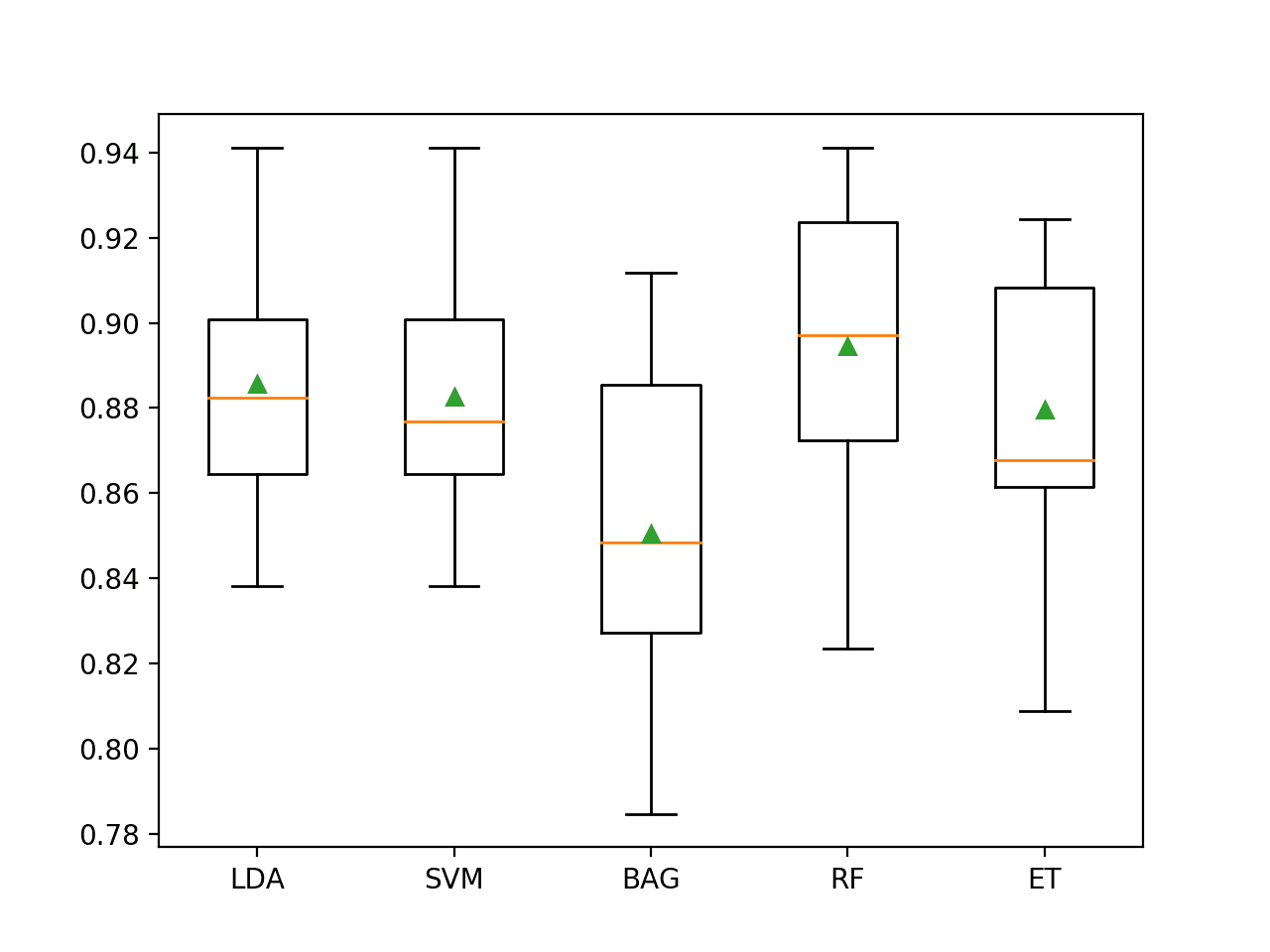
Box and Whisker Plot of Machine Learning Models on the Imbalanced E.coli Dataset
Evaluate Data Oversampling
With so many classes and so few examples in many of the classes, the dataset may benefit from oversampling.
We can test the SMOTE algorithm applied to all except the majority class (cp) results in a lift in performance.
Generally, SMOTE does not appear to help ensembles of decision trees, so we will change the set of algorithms tested to the following:
- Multinomial Logistic Regression (LR)
- Linear Discriminant Analysis (LDA)
- Support Vector Machine (SVM)
- k-Nearest Neighbors (KNN)
- Gaussian Process (GP)
The updated version of the get_models() function to define these models is listed below.
|
1 2 3 4 5 6 7 8 9 10 11 12 13 14 15 16 17 18 19 |
# define models to test def get_models(): models, names = list(), list() # LR models.append(LogisticRegression(solver='lbfgs', multi_class='multinomial')) names.append('LR') # LDA models.append(LinearDiscriminantAnalysis()) names.append('LDA') # SVM models.append(LinearSVC()) names.append('SVM') # KNN models.append(KNeighborsClassifier(n_neighbors=3)) names.append('KNN') # GP models.append(GaussianProcessClassifier()) names.append('GP') return models, names |
We can use the SMOTE implementation from the imbalanced-learn library, and a Pipeline from the same library to first apply SMOTE to the training dataset, then fit a given model as part of the cross-validation procedure.
SMOTE will synthesize new examples using k-nearest neighbors in the training dataset, where by default, k is set to 5.
This is too large for some of the classes in our dataset. Therefore, we will try a k value of 2.
|
1 2 3 4 5 6 |
... # create pipeline steps = [('o', SMOTE(k_neighbors=2)), ('m', models[i])] pipeline = Pipeline(steps=steps) # evaluate the model and store results scores = evaluate_model(X, y, pipeline) |
Tying this together, the complete example of using SMOTE oversampling on the E.coli dataset is listed below.
|
1 2 3 4 5 6 7 8 9 10 11 12 13 14 15 16 17 18 19 20 21 22 23 24 25 26 27 28 29 30 31 32 33 34 35 36 37 38 39 40 41 42 43 44 45 46 47 48 49 50 51 52 53 54 55 56 57 58 59 60 61 62 63 64 65 66 67 68 69 70 71 72 73 74 75 76 77 78 79 |
# spot check smote with machine learning algorithms on the ecoli dataset from numpy import mean from numpy import std from pandas import read_csv from matplotlib import pyplot from sklearn.preprocessing import LabelEncoder from sklearn.model_selection import cross_val_score from sklearn.model_selection import RepeatedStratifiedKFold from sklearn.svm import LinearSVC from sklearn.discriminant_analysis import LinearDiscriminantAnalysis from sklearn.neighbors import KNeighborsClassifier from sklearn.gaussian_process import GaussianProcessClassifier from sklearn.linear_model import LogisticRegression from imblearn.pipeline import Pipeline from imblearn.over_sampling import SMOTE # load the dataset def load_dataset(full_path): # load the dataset as a numpy array df = read_csv(full_path, header=None) # remove rows for the minority classes df = df[df[7] != 'imS'] df = df[df[7] != 'imL'] # retrieve numpy array data = df.values # split into input and output elements X, y = data[:, :-1], data[:, -1] # label encode the target variable y = LabelEncoder().fit_transform(y) return X, y # evaluate a model def evaluate_model(X, y, model): # define evaluation procedure cv = RepeatedStratifiedKFold(n_splits=5, n_repeats=3, random_state=1) # evaluate model scores = cross_val_score(model, X, y, scoring='accuracy', cv=cv, n_jobs=-1) return scores # define models to test def get_models(): models, names = list(), list() # LR models.append(LogisticRegression(solver='lbfgs', multi_class='multinomial')) names.append('LR') # LDA models.append(LinearDiscriminantAnalysis()) names.append('LDA') # SVM models.append(LinearSVC()) names.append('SVM') # KNN models.append(KNeighborsClassifier(n_neighbors=3)) names.append('KNN') # GP models.append(GaussianProcessClassifier()) names.append('GP') return models, names # define the location of the dataset full_path = 'ecoli.csv' # load the dataset X, y = load_dataset(full_path) # define models models, names = get_models() results = list() # evaluate each model for i in range(len(models)): # create pipeline steps = [('o', SMOTE(k_neighbors=2)), ('m', models[i])] pipeline = Pipeline(steps=steps) # evaluate the model and store results scores = evaluate_model(X, y, pipeline) results.append(scores) # summarize performance print('>%s %.3f (%.3f)' % (names[i], mean(scores), std(scores))) # plot the results pyplot.boxplot(results, labels=names, showmeans=True) pyplot.show() |
Running the example evaluates each algorithm in turn and reports the mean and standard deviation classification accuracy.
Note: Your results may vary given the stochastic nature of the algorithm or evaluation procedure, or differences in numerical precision. Consider running the example a few times and compare the average outcome.
In this case, we can see that LDA with SMOTE resulted in a small drop from 88.6 percent to about 87.9 percent, whereas SVM with SMOTE saw a small increase from about 88.3 percent to about 88.8 percent.
SVM also appears to be the best-performing method when using SMOTE in this case, although it does not achieve an improvement as compared to random forest in the previous section.
|
1 2 3 4 5 |
>LR 0.875 (0.024) >LDA 0.879 (0.029) >SVM 0.888 (0.025) >KNN 0.835 (0.040) >GP 0.876 (0.023) |
Box and whisker plots of classification accuracy scores are created for each algorithm.
We can see that LDA has a number of performance outliers with high 90-percent values, which is quite interesting. It might suggest that LDA could perform better if focused on the abundant classes.
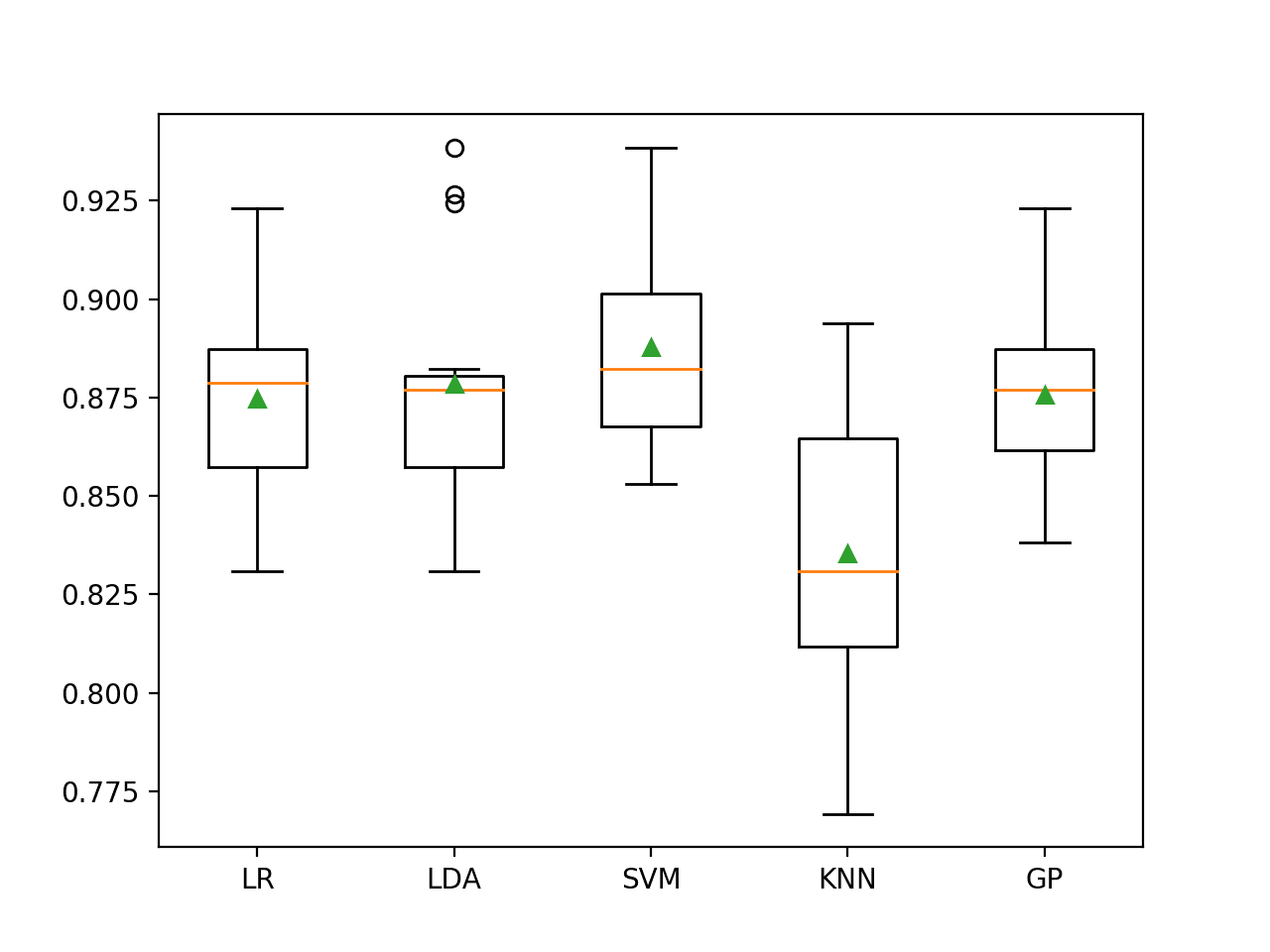
Box and Whisker Plot of SMOTE With Machine Learning Models on the Imbalanced E.coli Dataset
Now that we have seen how to evaluate models on this dataset, let’s look at how we can use a final model to make predictions.
Make Predictions on New Data
In this section, we can fit a final model and use it to make predictions on single rows of data.
We will use the Random Forest model as our final model that achieved a classification accuracy of about 89.5 percent.
First, we can define the model.
|
1 2 3 |
... # define model to evaluate model = RandomForestClassifier(n_estimators=1000) |
Once defined, we can fit it on the entire training dataset.
|
1 2 3 |
... # fit the model model.fit(X, y) |
Once fit, we can use it to make predictions for new data by calling the predict() function. This will return the encoded class label for each example.
We can then use the label encoder to inverse transform to get the string class label.
For example:
|
1 2 3 4 5 6 |
... # define a row of data row = [...] # predict the class label yhat = model.predict([row]) label = le.inverse_transform(yhat)[0] |
To demonstrate this, we can use the fit model to make some predictions of labels for a few cases where we know the outcome.
The complete example is listed below.
|
1 2 3 4 5 6 7 8 9 10 11 12 13 14 15 16 17 18 19 20 21 22 23 24 25 26 27 28 29 30 31 32 33 34 35 36 37 38 39 40 41 42 43 44 45 46 47 48 49 50 51 52 53 54 55 56 57 58 59 |
# fit a model and make predictions for the on the ecoli dataset from pandas import read_csv from sklearn.preprocessing import LabelEncoder from sklearn.ensemble import RandomForestClassifier # load the dataset def load_dataset(full_path): # load the dataset as a numpy array df = read_csv(full_path, header=None) # remove rows for the minority classes df = df[df[7] != 'imS'] df = df[df[7] != 'imL'] # retrieve numpy array data = df.values # split into input and output elements X, y = data[:, :-1], data[:, -1] # label encode the target variable le = LabelEncoder() y = le.fit_transform(y) return X, y, le # define the location of the dataset full_path = 'ecoli.csv' # load the dataset X, y, le = load_dataset(full_path) # define model to evaluate model = RandomForestClassifier(n_estimators=1000) # fit the model model.fit(X, y) # known class "cp" row = [0.49,0.29,0.48,0.50,0.56,0.24,0.35] yhat = model.predict([row]) label = le.inverse_transform(yhat)[0] print('>Predicted=%s (expected cp)' % (label)) # known class "im" row = [0.06,0.61,0.48,0.50,0.49,0.92,0.37] yhat = model.predict([row]) label = le.inverse_transform(yhat)[0] print('>Predicted=%s (expected im)' % (label)) # known class "imU" row = [0.72,0.42,0.48,0.50,0.65,0.77,0.79] yhat = model.predict([row]) label = le.inverse_transform(yhat)[0] print('>Predicted=%s (expected imU)' % (label)) # known class "om" row = [0.78,0.68,0.48,0.50,0.83,0.40,0.29] yhat = model.predict([row]) label = le.inverse_transform(yhat)[0] print('>Predicted=%s (expected om)' % (label)) # known class "omL" row = [0.77,0.57,1.00,0.50,0.37,0.54,0.0] yhat = model.predict([row]) label = le.inverse_transform(yhat)[0] print('>Predicted=%s (expected omL)' % (label)) # known class "pp" row = [0.74,0.49,0.48,0.50,0.42,0.54,0.36] yhat = model.predict([row]) label = le.inverse_transform(yhat)[0] print('>Predicted=%s (expected pp)' % (label)) |
Running the example first fits the model on the entire training dataset.
Then the fit model is used to predict the label for one example taken from each of the six classes.
We can see that the correct class label is predicted for each of the chosen examples. Nevertheless, on average, we expect that 1 in 10 predictions will be wrong and these errors may not be equally distributed across the classes.
|
1 2 3 4 5 6 |
>Predicted=cp (expected cp) >Predicted=im (expected im) >Predicted=imU (expected imU) >Predicted=om (expected om) >Predicted=omL (expected omL) >Predicted=pp (expected pp) |
Further Reading
This section provides more resources on the topic if you are looking to go deeper.
Papers
- Expert System For Predicting Protein Localization Sites In Gram‐negative Bacteria, 1991.
- A Knowledge Base For Predicting Protein Localization Sites In Eukaryotic Cells, 1992.
- A Probabilistic Classification System For Predicting The Cellular Localization Sites Of Proteins, 1996.
APIs
- pandas.read_csv API.
- sklearn.dummy.DummyClassifier API.
- imblearn.over_sampling.SMOTE API.
- imblearn.pipeline.Pipeline API.
Dataset
Summary
In this tutorial, you discovered how to develop and evaluate a model for the imbalanced multiclass E.coli dataset.
Specifically, you learned:
- How to load and explore the dataset and generate ideas for data preparation and model selection.
- How to systematically evaluate a suite of machine learning models with a robust test harness.
- How to fit a final model and use it to predict the class labels for specific examples.
Do you have any questions?
Ask your questions in the comments below and I will do my best to answer.

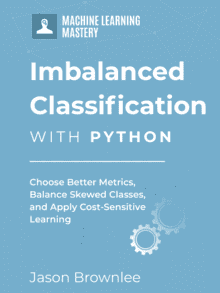
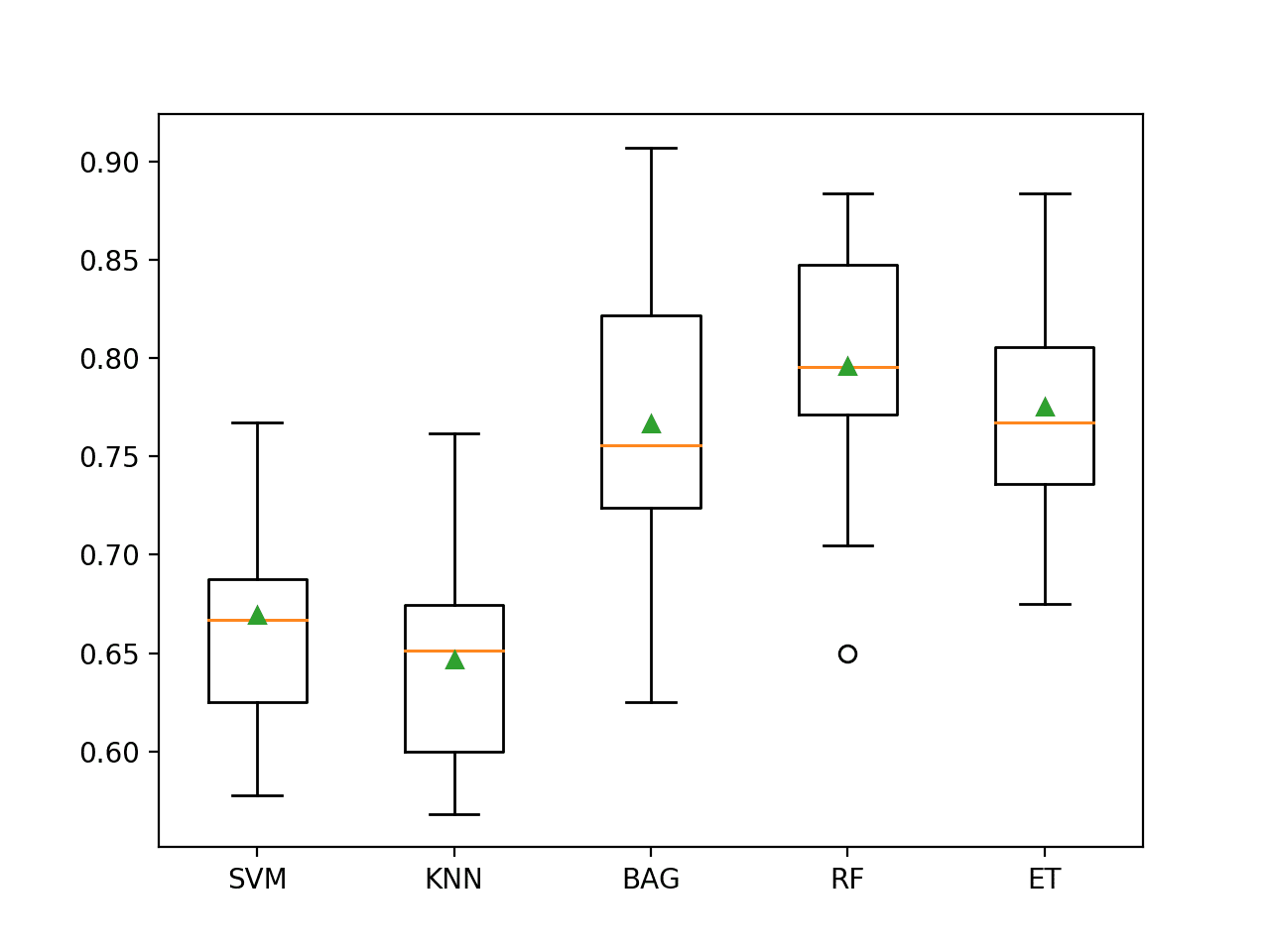





Alright, Jason! Great code!
I have several questions, and I hope to get your kindly answers.
SVM and KNN classifiers have better time performances than the Random Forest Classifier, about 17 times faster, and accuracy is just a 1% difference, Wouldn’t it be better to use those algorithms instead of Random Forest to do the final predictions? I guess these performances (elapsed time in execution) will have a tremendous influence dealing with a massive volume of data
Could you include in your blog section a tutorial, something like How to use Pipelines in KFold validations: Advantages and Disadvantages? Pipelines with KFolding from Zero to Hero?
Are there other datasets about E.coli to run the previously trained models to predict unknown targets?
Cheers!!!
Maybe.
One must choose a model based on the project requirements, e.g. not just model performance, but also variance and computational complexity:
https://machinelearningmastery.com/a-gentle-introduction-to-model-selection-for-machine-learning/
Sure. What questions do you have about pipelines exactly? Maybe email me:
https://machinelearningmastery.com/contact/
Sorry, I don’t follow your last question. Perhaps you can elaborate?
Hello Jason,
is there any way to benefit from a very power Nvidia GPU as GTX 2080 using your examples for classification ?
Rgds
dom
No, examples run on CPU.
Hallo Jason,
first of all thanks to invite us in this incredible world with your great work
I’d like your comment on this results (10000 Training vectors, each one is 60 estimators) :
using your python code with evaluate_model on ExtraTreesClassifier
I get an accuracy score that is 83.3%
while in validation (so using function model.fit on training data and model.predict on unseen data) I have an accuracy that is 53%
how can I interpret such results ?
did the model not generalize on never seen data ?
Thanks in advance
Dom
The model does well on train and poor on test.
It has not generalized well or the test dataset is not representative.
Hi Jason,
thanks for your reply….
so the model didn’t generalize … OK … this is clear …
but the point I don’t undertand is :
what does it mean that evaluate_model on ExtraTreesClassifier result in 83.3% accuracy
if on test data the real accuracy is 53% ?
I don’t get this
during validation I have:
training data : Train_X,Train_y
model.fit(Train_X,Train_y)
print(‘model.score=’,model.score(Train_X,Train_y)) -> 100%
validation data: Valid_X,Valid_y
print(‘model.score=’,model.score(Valid_X,Valid_y)) -> 53%
I dont understand… am I doing something wrong ?
Thanks in advance
Dom
Evaluation of the model via a training set is an invalid estimate of model performance.
This is why we use a hold out set or cross-validation.
The only evaluation you have in your case is an estimate of performance on the val set which is 53%.
Thanks very much for sharing this Jason! It was very insightful, as always.
I have a question regarding the choice of ‘accuracy’ as metric. Are there any other scores you’d recommend given the class imbalance? I know one could choose G-mean, balanced accuracy, etc for imbalanced binary classification but would they be also applicable to multi-class case?
Many thanks in advance,
You’re welcome.
Yes, I liked accuracy for this dataset.
Yes, you can choose another metric, see this tutorial:
https://machinelearningmastery.com/tour-of-evaluation-metrics-for-imbalanced-classification/
Hi Jason! Since oversampling did not improve accuracy, can we conclude that the data imbalance was not a “problem” here? Why was it not a problem? Was it because we looked at accuracy, but not for example the recall & precision (or diagonals of normalized confusion matrix) of each individual class separately? Is it because the features were predictive enough of the target that we were able to do much better than the baseline accuracy?
That’s right. You need to look at recall, precision, and the relationship of features to the result too. Think of some exaggerated examples: If the imbalance is a billion to one, even if I oversampled a hundred time, if I always predict for the heavier weighted result, I still get the same accuracy. If the result is a random number unrelated to the feature, the model cannot improve no matter what technique you’re using. Think about your level of accuracy is staying too high or too low. Then you may get an idea of what problem it is.
The below code snippet is returning one of the value in y as ‘0’ , hence ending up throwing an error like -“ValueError: The least populated class in y has only 1 member, which is too few. The minimum number of groups for any class cannot be less than 2.”
X, y = data[:, :-1], data[:, -1]
# label encode the target variable to have the classes 0 and 1
y = LabelEncoder().fit_transform(y)
Hi MaMo…hanks for asking.
I’m eager to help, but I just don’t have the capacity to debug code for you.
I am happy to make some suggestions:
Consider aggressively cutting the code back to the minimum required. This will help you isolate the problem and focus on it.
Consider cutting the problem back to just one or a few simple examples.
Consider finding other similar code examples that do work and slowly modify them to meet your needs. This might expose your misstep.
Consider posting your question and code to StackOverflow.